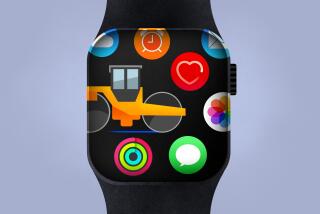Sculley Charts 21st Century Fantasy
- Share via
Plans for computer products usually are carefully guarded secrets. But an Apple Computer insider has been circulating a description and crude drawing of a machine so advanced that it could convert “vast quantities of information into personalized and understandable knowledge.”
Unlike today’s computers, this machine doesn’t require that the user know how to type. It understands voice commands.
On top of that, the color display would provide animated video along with high-resolution computer text and graphics. The high-fidelity sound would be better than any stereo system and would be able to produce a synthesized human voice in any language or dialect.
The person responsible for these disclosures hasn’t been fired. In fact, it’s Apple’s chairman and chief executive, John Sculley. But the fantasy product, nicknamed “Knowledge Navigator,” is not about to appear on your dealer’s shelves anytime soon. It’s part of the vision for the 21st Century that Sculley described in a recent interview and in his new book, “Odyssey: Pepsi to Apple . . . A Journey of Adventure, Ideas and the Future.”
In the book, Sculley traces his career back to Pepsi, where he served as president until then-Apple Chairman Steven P. Jobs persuaded him to leave his comfortable Upstate New York life style to lead the youth brigade at Apple’s Cupertino campus. Like other CEO authors who have successfully guided their companies through rough times, Sculley shares his up and downs, including the well-publicized souring of his friendship with Jobs, who Sculley eventually fired. Although some of Sculley’s book amounts to an airing of dirty laundry, I was impressed with the book’s epilogue, where Sculley describes the Knowledge Navigator and other ideas being explored at Apple and other Silicon Valley companies.
Sculley’s computer of the future would rely on artificial intelligence software to make sophisticated decisions, serving as the user’s “agent,” or highly trusted executive assistant. Such agents, according to Sculley, “will become smart enough to learn that you like certain types of information presented in certain ways.” Knowing your interests, for example, it periodically would sign on to appropriate electronic libraries and information services and then present you with summaries of the information.
Although Knowledge Navigator is years away, Apple already offers a programming language for the Macintosh demonstrating some of its concepts. HyperCard, introduced in August, makes it simpler for people to use or write programs. For instance, novices easily can sift through what appears on the screen as stacks of index cards. And using HyperCard, Danny Goodman, a computer journalist but not a programmer, created “Business Class,” software that allows a user to find information about a country by pointing to it on a map.
Sculley’s book reflects his excitement about the industry that he joined only a few years ago. He frequently contrasts Apple with Pepsi, describing the soft-drink giant as a “second wave” industrial age company and Apple as an information age, or “third wave” organization.
Apple always has been at the vanguard of the personal computer revolution. Its founders, Jobs and Steven Wozniak, were heroes to computer hobbyists. Apple stockholders meetings once looked more like 1960s political rallies than business functions. But Apple now ranks 190th on the Fortune 500 list, and its Macintosh is making inroads in the corporate computing environment once dominated by IBM PCs and compatible machines.
What’s more, Apple and IBM equipment is beginning to look more alike. The Mac II is styled much like IBM’s PCs. And IBM’s newest PC, the Model 25, resembles the Macintosh Plus and SE.
In addition, IBM has announced plans to switch to a graphic user interface like that in the Macintosh. That new package of software and equipment would allow IBM computers to work with a hand-held mouse, giving users more control over the appearance of the text and graphics on the screen. There also are add-in boards from other companies that make it possible for Macintoshes and Apple IIs to run IBM software.
These developments notwithstanding, Sculley maintained that “the fundamental visions” of Apple and IBM “are radically different.” IBM’s vision, Sculley said, “starts with the mainframe” and focuses on institutions, whereas “Apple’s vision focuses on the individual.” Apple’s goal, he said, is to “make individuals more productive, which will ultimately result in the institution becoming more productive as well.”
Whether the equipment is from Apple, IBM or another company, personal computer users often have a strong attachment to their machines. User groups, where people get together to exchange information and copies of public domain software programs, are thriving, sometimes meeting in large auditoriums to accommodate hundreds of members. Publications aimed at the users of specific machines, including PC and MacWorld magazines, are thriving.
Why are people so enthusiastic about their computers? “People are recognizing that we are clearly in the information age,” Sculley said. “Those people who can learn how to work with information are going to be in a far better position in this world than people who can’t.”
Computer File welcomes readers’ comments but regrets that the authors cannot respond individually to letters. Write to Lawrence J. Magid, 3235 Kifer Road, Suite 100, Santa Clara, Calif., 95051, or contact the L. Magid account on the MCI electronic mail system.






